A prelude...
Collecting firearms is getting harder and harder all
over the world, but one field of interest is still without restrictions
in most free countries of the Western hemisphere; flare guns and their
accessories. The simple reason for this is that flare guns are still in
use as survival equipment in civilian trades.
The
number of models and varieties is almost unlimited, but in this article
I will focus solely on the workhorse of the Wehrmacht; Fritz Walther's
"Leuchtpistole" that was manufactured from 1926 until 1943. It was used
within all branches of the Wehrmacht up until the end in 1945, and then
continued its service life in several armies postwar. It is still in
regular use in the Norwegian army today.
It was issued in a
handful of varieties that all have the same basic construction and
functionality, but differs in details, materials and markings.
Collectors love these variations, as there is really no limit
to how they can collect flare guns; from the main varieties to
production year or serial number!
The
flare gun is a product with far more than strictly military value. In
Germany they were manufactured during the prewar era for export, for
the commercial market, for the police and several other paramilitary
organizations. These flare guns do not stand out as any different from
the military production, but they can be identified by the markings.
The scope of this study will be the flare guns manufactured for the
Wehrmacht (Heer). Markings will be covered with focus on the standard
military contracts and the differences between the different
manufacturers. This should enable the reader to tell the military and commercial contract flare guns apart.
In
an attempt to get things right I have once again gone back to the
original written sources and studied as many surviving specimens as
possible. And once again a lot of new knowledge has been gained...
The
story begins
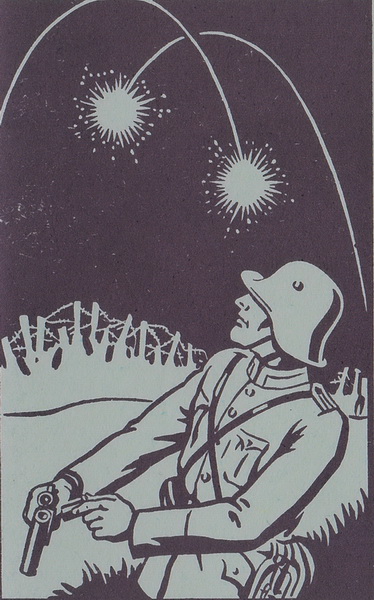
Cover
art; «Die Leuchtpistole und ihr Gebrauch», Heinz Denckler Verlag, 1935
The use of purpose
built handguns to fire light- and signaling pyrotechnics didn't really
catch on until the
Russian-Japanese war in 1904-05, and it became a standard "tool of the
trade" during the Great War. In the early days the use of the flare gun
was limited to shooting flares to illuminate the battlefield at
nighttime. The guards in the trenches could fire a single flare to
light up the terrain in front of him to see if imminent danger was
present. The advantages of this was that the light was emitted on the
spot the guard needed it, exactly when he needed it. The disadvantage
was that the firer's position would be revealed, and that the light
emitted would be short-lived, normally around 7
seconds. In
adition to white flares being used to illuminate the battlefield, it
was soon used as a tactical tool. A variety of different combinations
of colored lights, number of stars, colored smoke, and sound was
manufactured. The flare gun was also used as a practical tool to
conduct land survey, to make weather forecasts and as distress-signals
on land, water or in the air.
The standard flare gun used by the Central powers during the Great War
is today called "Hebel" or "Model Hebel". This designation does
not relate to any manufacturer, but is the German word for the lever in
front of the trigger guard that was
used to release the lock between the barrel and the frame. The official
name of the flare gun was "Leuchtpistole Model 1894", and it was
designed by the "Ingenieurkomitee des Heerespionier-Corps",
as the use of flare guns was initially linked to trenches and
fortifications that sorted under the engineering corps. Flare gun M/1894
was manufactured in large numbers by many manufacturers. Until now, 28
different makers have been identified in 4 countries.
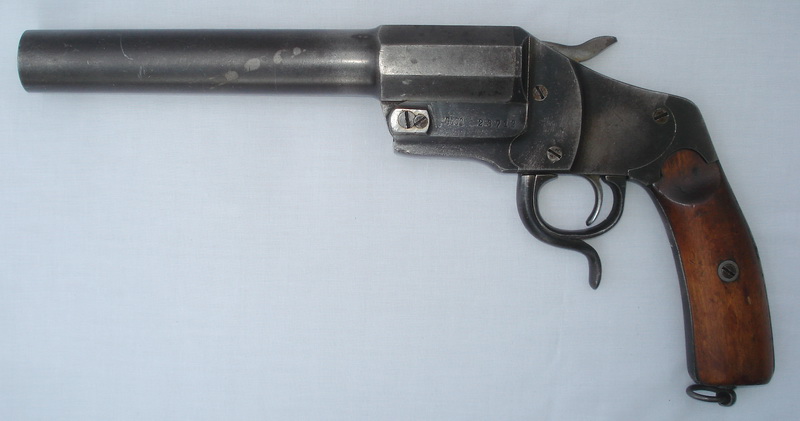
Leuchtpistole
M/1894
In an effort to reduce
the ability of the Central Powers to wage war again, the Versailles
Treaty of 28 June 1919 imposed restrictions on the size of the
respective armies and the type of weapons they could be equipped with.
The German army was restricted both in terms of the number of units,
number of officers and men, as well as weapons. At the same time, large
quantities of weapons were unaccounted for in Germany after World War
I, and the authorities had initiated a mortgage scheme in which the
citizens received a sum of money if they handed in military
weapons. To prevent the soldiers from stealing weapons to get the
prize-money, the Reichswehr's weapons were marked "1920". This also
applied to the flare gun M/1894.
Weapons that were no longer allowed in the newly created "Vorläufige
Reichswehr" and the later "Reichswehr" were to be destroyed or disposed
of, and this also included all types of flare guns.
In the end this
resulted in the need for a new flare gun. Losses had to be
covered, and flare guns wrecked due
to wear and tear had to be replaced, and in addition the increased
needs due to
reorganization and newly developed combat techniques had to be met.
In addition, there was a growing commercial market for flare guns; within
law enforcement, railroad services, civilian shipping and
the ever-increasing civil aviation. The flare gun Model 1894 (Hebel) was
a
tried construction but had some flaws and weaknesses. It was poorly
balanced, the parts were hand-fitted and it had a protruding hammer.
Furthermore, the gun was constructed with forged leaf springs that were
subjected to breakage and weakening, and it lacked a spring-loaded
barrel release/opening. It was only the effect of gravity that made the
barrel pivot around the front screw to allow access to the
chamber.
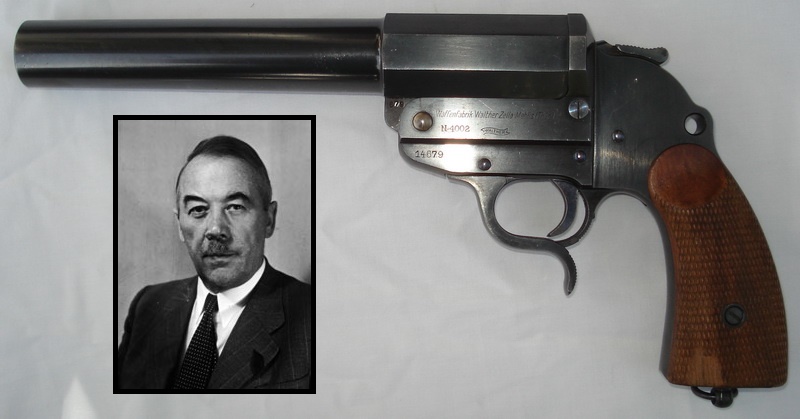
Enter Fritz Walther's Leuchtpistole!
All this led to a new
flare gun being constructed by Fritz Walther at
Waffenfabrik Walther, Zella-Mehlis in the period 1923-1926. The factory
applied for a patent on the gun on December 26, 1926, and this was
granted in 1930.
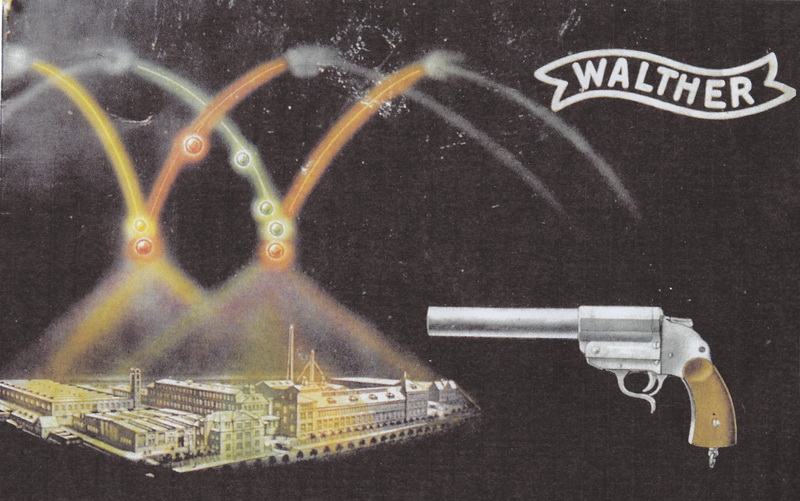
The old and the new
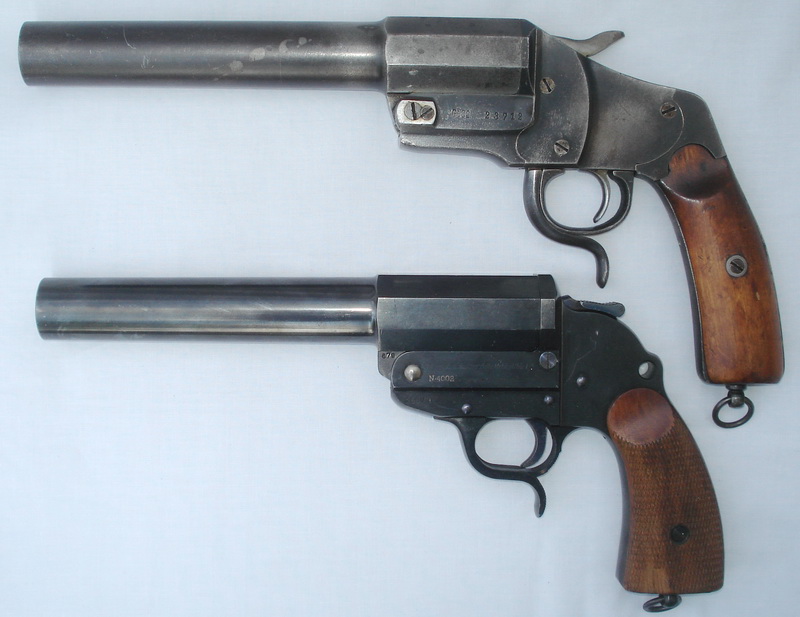
A comparison shot of the
old Leuchtpistole Model 1894 and Walther’s new Leuchtpistole
When Fritz
Walther's new invention is placed side-by-side with the flare gun
M/1894, the relationship is pretty obvious. The special shape of the
barrel, with the octagonal part at the rear end as reinforcement
around the chamber, is a clear handover from the M/1894. The
same goes for the lever arm, the "Hebel", which follows the contour of
the trigger guard. It also retained the same barrel length as the
M/1894, and the weight remained almost unchanged. It was 3 cm shorter,
since the grip and trigger arrangement was moved forwards, something
that improved the balance greatly. Unfortunately, no background
information regarding the new construction has survived, apart from the
original patents. Whether it was a commission from the Reichswehr, or
whether Fritz Walther constructed this for commercial sale is not known
today.
It was marketed and sold commercially as the "Walther-Leuchtpistole",
at the same time as orders for the Reichswehr were being made.
In the Reichswehr it was simply called "Leuchtpistole".
Dating the actual introduction of the Leuchtpistole to the Reichswehr
has proven difficult. The first edition of the Leuchtpistole was not
marked with a year of manufacture on the frame, and it can't be
dated using the serial number, although this may give an
indication. The earliest indicators I have found is a photograph of the
marking on a standard military model holster dated 1928. The
earliest regulations or manuals identified are the "D 884 Richtlinien
für das Zerlegen und
Zusammensetzen der Leuchtpistole" from 1929.
The construction was completed in 1926, and it was commissioned by
the Reichsheer sometime during the period 1926 - 1928, although the
patent was
not granted until 1930. Collectors like to refer to this as Model 26,
but this is no official model designation.
Walther's
new flare gun was ingeniously designed, with several new features
developed specifically for this construction. The entire gun is
held together by pins that individually lock the different parts in
position, while the individual parts hold the pins in place when put
under pressure by the spring pressure from the trigger guard
(for the trigger
mechanism), and the locking lever spring which holds the barrel open
(for
the barrel parts). There is only one screw on the entire gun, and it is
the screw that holds the grip plates together. In the patent
application for the flare gun, it is stated that vibrations using other
flare guns assembled with screws caused the screws to fall out during
use, but that the use of locked pins on this model eliminates this
problem.
Technical data:
Length 326 mm
Height with lanyard ring 179 mm
Thickness 36 mm
Weight 1410 grams
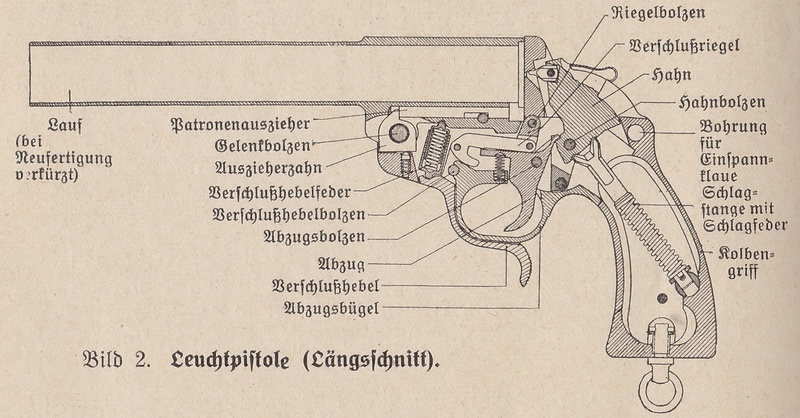
Picture
from Waffentechnische Unterrichtsbuch, 1940
The flare gun has no manual safety, but it is equipped with several
functions that will prevent the untimely pulling of the trigger. The
locking lever rod makes it impossible
to pull the trigger if the locking latch is not fully locking the
barrel to the frame, or if the barrel is fully open. The
hammer
spring rod is
designed to retract the firing pin into the frame after the impact on
the cartridge primer, once the trigger has been pulled. The firing pin
will, due to this, not be in physical contact with the cartridge primer
during the opening and closing of the barrel. The trigger and hammer
are designed in a way that will not allow the hammer to go forward
again without the trigger being pulled. It is thus impossible to
obtain an unintentional misfire by the flare gun falling onto the hammer
or due to the hammer being forced forward without the trigger
being pulled
simultaneously. In addition to this, the hammer got a new design that
made it
follow the contours of the frame piece, and it no longer stood out like
a sore thumb as it did on the M/1894.
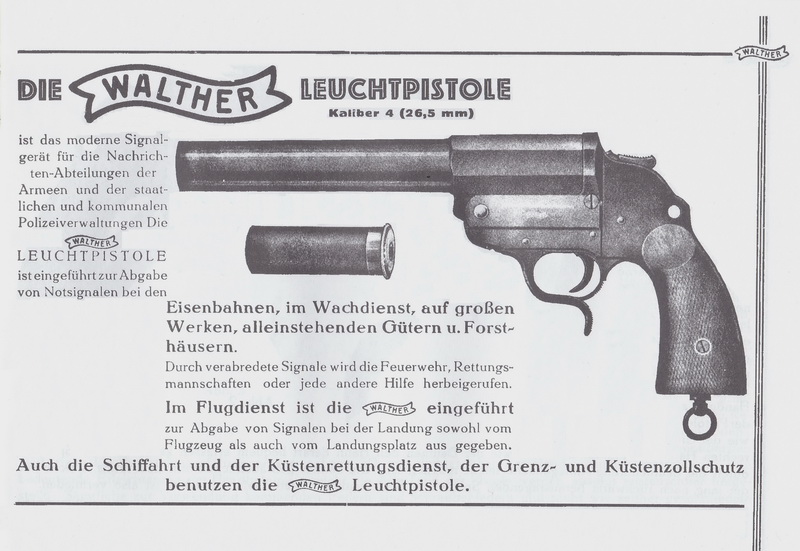
Excerpt from Waffenfabrik Walther's sales brochure
from the early
1930s
According
to the sales prospect from the Walther factory, all parts have been
manufactured with the highest accuracy, making replacement of parts
very easy. This point is worth noting. Today we take this for granted,
but in the 1920s the parts were manufactured with large tolerances.
These were then hand-fitted to the individual gun. Thus, for example, a
pair of grip plates did not
necessarily fit on guns other than the one they were fitted to. This is
also a selling point in the WUM catalog from
1932, Walther’s flare gun is presented as "machine manufactured", as
opposed to flare gun M/1894 which was still in commercial sale. Only the
frame and the barrel are numbered on Walther's flare gun, while the
previous flare gun M/1894 has serial numbered parts all the way down to
the
screws.
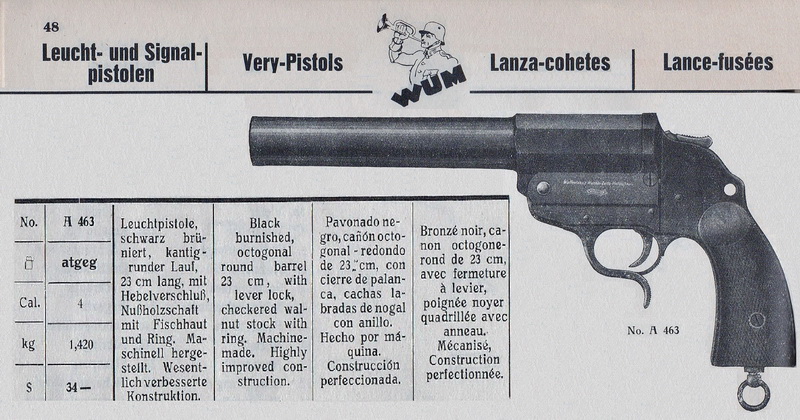
The WUM catalog from 1932.
Picture courtesy of
Vidar Andresen
The
flare gun was only manufactured in one caliber, the German "Kaliber 4", sometimes
also described as "Cal. 4". This
was equal to 26.65
mm. This
caliber had been set as a minimum size for pyrotechnic ammunition by
the
Engineering Committee set up by the Prussian War Ministry as early as
25
January 1901. The
chosen caliber provided sufficient opportunity for satisfactory burning
time, with acceptable recoil for hand held firing. "Load-capacity" was
eventually not good enough though; this was later
solved by extending the length of the case for special purpose
ammunition.


 The
history of Die Leuchtpistole
The
history of Die Leuchtpistole